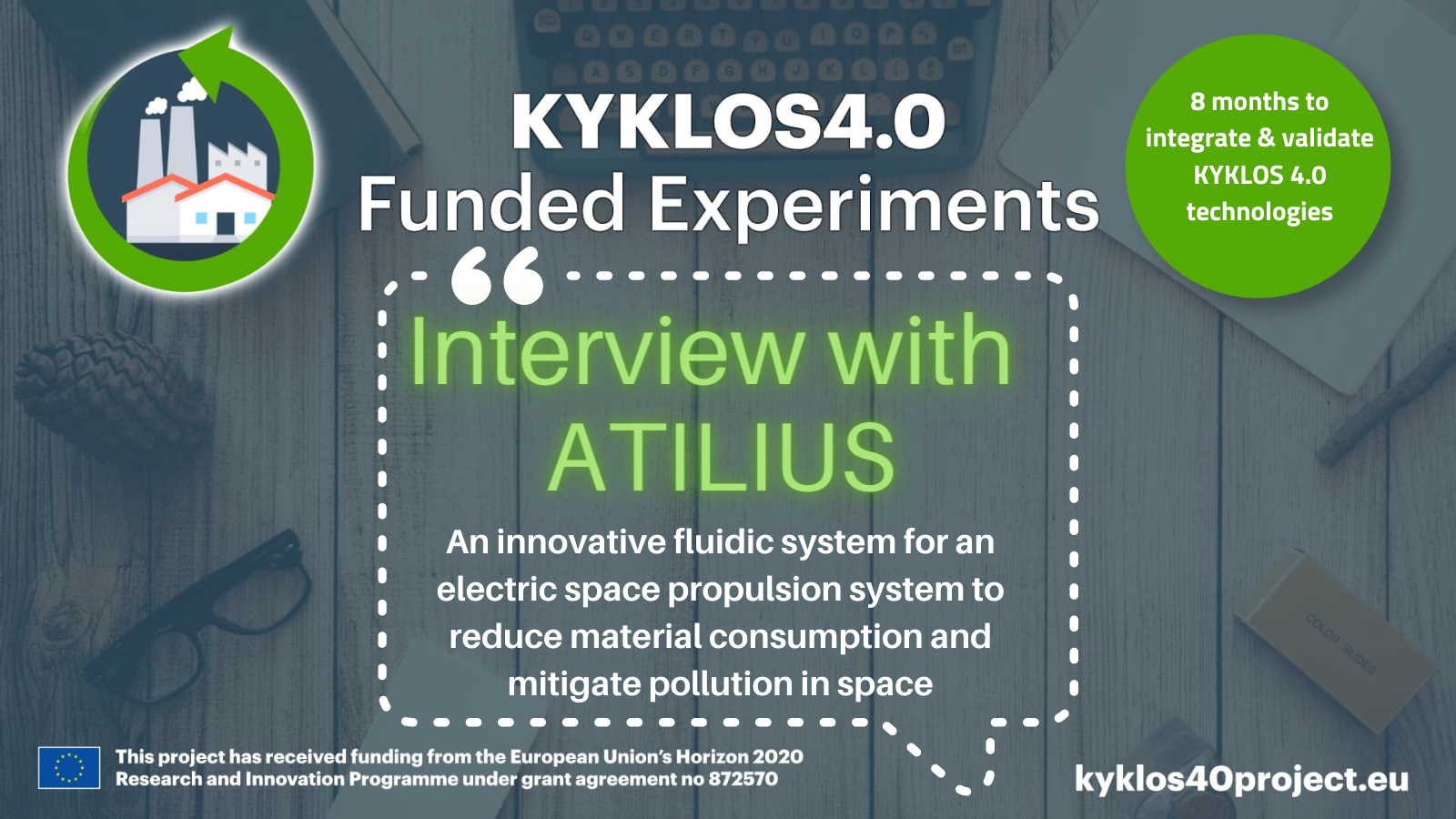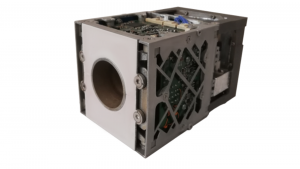
12 May Interview with the ATILIUS experiment
The KYKLOS4.0 Open Call #2 is funding seventeen experiments that are developing technological solutions of value for the manufacturing domain.
The project will be releasing a series of interviews over the course of the coming weeks with the objective of promoting the work being implemented in these experiments and allowing our readers to understand potential uptake of the solutions being developed by them.
This is the fourth of the seventeen interviews with the experiments funded under the open call. Today, we interview the ATILIUS experiment.
* * * * *
Explain your project in one sentence.
The ATILIUS project goal is the design, manufacturing, and testing of the fluidic subsystem of REGULUS-50-I2, a space plasma thruster for small satellites and CubeSats. The new ATILIUS design will enhance the efficiency of operations, and printability, lowering the environmental impact by using powders produced from scrap.
How is KYKLOS4.0 project and the selected services (and components) bringing value to your project?
KYKLOS 4.0 brought the opportunity to tackle the problem of sustainability and efficiency of the REGULUS fluidic subsystem, giving us the opportunity to collaborate and form a well-balanced consortium. Moreover, KYKLOS 4.0 services will be used to monitor the impact and the processes. More specifically, the Rapid Prototyping Module will be used in the next weeks to verify and enhance the printability of the first breadboard by controlling the chosen parameters (e.g., material, machining, etc.). Thanks to this service, insights on the best processes to be applied will be obtained, the structural performances will be inferred. The whole process will be monitored through the LCA Simulation Engine to quantify the environmental impact of the production and of the product. The data collected will be then used to enhance the printability and reduce the impact of the second breadboard. Finally, the Marketplace service will be used to identify the market needs related to small satellites and CubeSats segments. This will further tune the design of the ATILIUS fluidic subsystem to match the market expectation in terms of manufacturing, costs, and performances.
How is your solution contributing to circular manufacturing?
The design of ATILIUS is non-trivial, especially from a material point of view. In fact, REGULUS-50-I2 is a plasma thruster that uses iodine as propellant. Iodine is a chemically reactive element that tends to corrode several commonly used materials. For this reason, the material of which the fluidic subsystem is composed has been carefully evaluated. Among others, superalloys such as Inconel are the most suitable. Inconel is an expensive and difficult to shape material, with a high rate of failure when machined. In order to decrease the production waste related to the manufacturing of the ATILIUS system, the powders used for 3D printing come from scrap and discarded pieces and parts. By doing so, the cost of the system will decrease, as well as the environmental impact of the finished product, in a recycling-oriented approach. This approach will ensure the circularity of the manufacturing process, that will be carefully monitored and measured throughout the entire project.
How will your solution be replicated and used in other manufacturing environments?
The ATILIUS project tackles several common problems in different fields. First, the corrosive nature of iodine drove the material choice and, consequently, the processes. The lessons learnt during ATILIUS in machining and 3D printing corrosive-resistant material will be beneficial for applications that use chemically reactive compounds as iodine. Moreover, the ATILIUS subsystem will be mounted on satellites, so the requirements in terms of volume, weight and mechanical robustness are stringent. The design and manufacturing processes resulting from this project will pave the way for guidelines and good practices in the manufacturing of space qualified components. Moreover, the heat exchange and the evaporation of the solid iodine will be analysed, modelled, and deeply studied with a dedicated numerical tool that will be developed during the ATILIUS project in order to enhance the efficiency of the fluidic subsystem. This numerical tool can be applied to different processes that involve phase changing materials to increase efficiency (e.g., heat exchanger, evaporator, etc.).
What advice would you give to companies wishing to make their manufacturing processes more circular?
Making an established process more circular is often non-trivial. First, what works is rarely changed to make it work better or in a more sustainable way. Second, it is not always possible to change or adjust a specific design or process that is already optimised for means other than sustainability and circularity. However, sustainability of products and manufacturing processes is becoming urgent to decrease the environmental impact of our lives. In this framework, engineers and designers should design for recycling from a very early stage. This holds true for both products and processes. More specifically, the design of a product or process should take into considerations the 5 Rs of circular economy (i.e., refuse, reduce, reuse, repurpose, and recycle) from the beginning of the designing phase, by identifying shapes, materials, processes, and machining that is easy to recycle at the end of the product life and that are capable of reducing waste and pollution. Thus, the design-for-recycling approach should be included in the design process as a routine method, not considered as a nice to have.

* * * * *
About the ATILIUS project
The ATILIUS project – Additive Technologies for Innovative Low-thrust Iodine space Unit from Scrap – is implemented by three partners: Technology for Propulsion and Innovation S.p.A. (Italy), Aidro S.r.l. (Italy), Optimad S.r.l. (Italy).
Summary: The main objective of the project is to introduce an innovative fluidic system for an electric space propulsion system for CubeSats that will reduce material consumption and waste on Earth and mitigate further pollution in space.

